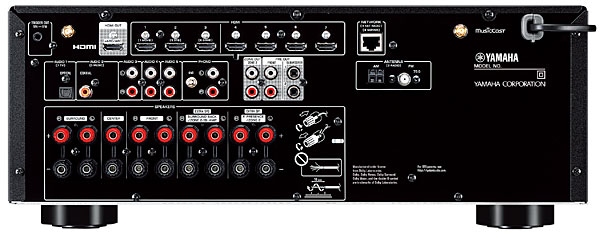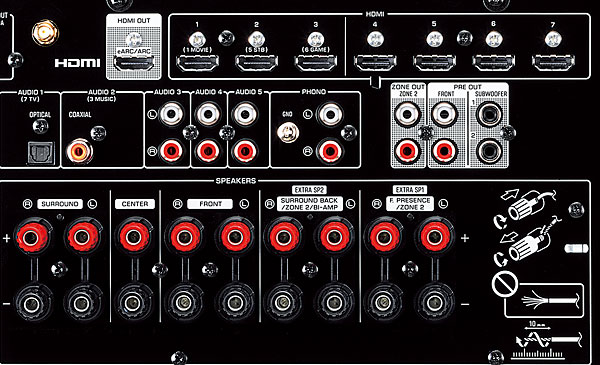I kinda like the new design, but i'll never forgive Yamaha that smallish crappy ugly dot matrix display with no active channels indcators!.I'm waiting for release (and i'll probably buy it) of the Aventage RXA6A or RXA8A and it looks that they'll have the same display. Grrrrrrr. WTF? Come on, In 2021 the big Yamaha receivers should have a big colour LCD display or at least the last year excellent displays and not this embarrasing new ones...
Yamaha RX-V6A 7.2-channel A/V Receiver Review

AT A GLANCE
Plus
HDMI 2.1-ready (via firmware update)
Versatile speaker switching
Built-in phono preamp
Minus
Small front panel and onscreen displays
Lacks analog video connections
THE VERDICT
Yamaha's latest mid-priced A/V receiver promises—and delivers—cutting-edge features at an unprecedented price.
The big car companies refresh their lineups on a pretty regular schedule. Honda, for example, brings out all-new versions of its models every four to five years, and it makes smaller upgrades and improvements in the years between the big changes. How many people know that the A/V receiver manufacturers do pretty much the same thing? Much like a car, an A/V receiver is built on a platform, one that can be upgraded and modified over time as new features are added. But there eventually comes a point where the only practical way forward is to start fresh with a clean-sheet design. That's where Yamaha's latest mid-priced RX-V receiver line comes in.
Launched with just two models, the RX-V4A ($440) and the subject of this review, the RX-V6A ($600), these all-new receivers offer a fresh design aesthetic, with just two major controls visible on the shiny black plastic front panel, which has rounded side corners to soften the look. A huge central volume knob dominates the front, with a smaller multi-function knob on the right side. No display is visible until you turn on the power, when an LCD display screen lights up. A row of hidden touch switches running along the lower edge gives instant access to programmable scene settings and other minor controls. The main power switch, a 1/4-inch headphone output, A USB type-A port, and a socket for the supplied YPAO room correction microphone round out the front panel's feature set.
Features
Designing a $600 A/V receiver is a delicate balancing act where you have to determine the best blend of performance and features to meet the needs of users. It's also important to be forward-thinking and anticipate what future tech developments are headed down the pike. The RX-V6A shows a lot of this type of planning, with several highly anticipated features promised through upcoming firmware updates.

The goal for any mid-priced receiver is to deliver a big dose of the features you'd expect from a fancy flagship model, but at a more reasonable cost. Yamaha made some bold decisions to get there with the RX-V6A. For example, with seven channels of onboard amplification but a total of nine speaker connections, you can set up a rig that handles both 7.1 surround and 5.1.2 Dolby Atmos with added height speakers, and then let the receiver automatically select the appropriate speakers to use based on the source material being played. Adding to the versatility, the two configurable channels can be used to power a second zone, or to bi-amp your main left and right speakers.

Another bold decision Yamaha made was to dispense with all analog video inputs and outputs. Sure, pretty much every modern source component has an HDMI output, but some people really like their retro gaming consoles, or will occasionally dust off the old camcorder to watch home movies. With the RX-V6A, you would need to use some kind of analog-to-HDMI converter to do that. Ironically, the RX-V6A does accommodate a few even more ancient legacy formats with its analog AM/FM radio tuner and back-in-style phono input for a turntable. One plus is that with all those composite- and component-video connections gone, the ridiculously overstuffed A/V receiver back panel of the past is now history, with plenty of real estate left for the RX-V6A's connectors.
As you would expect from an A/V receiver built on a new platform, the RX-V6A's potential feature set is bang-up-to-date. The reason I say "potential" is because, as I write this, many of the RX-V6A's more cutting-edge features exist only as future firmware updates. As it stands, the RX-V6A's video support covers 4K/60, 4:4:4 at 18Gbps, and Dolby Vision and Hybrid-Log Gamma HDR. Promised firmware updates will upgrade three of its seven HDMI inputs with HDMI 2.1 features including 4K/120Hz and 8K/60 video pass-through, as well as gamer-centric VRR (variable refresh rate), ALLM (auto low latency mode), QFT (quick frame transport), and QMS (quick media switching). Other promised updates will add HDR10+ HDR support and Dolby Atmos Height Virtualization.
- Log in or register to post comments


I kinda like the new design, but i'll never forgive Yamaha that smallish crappy ugly dot matrix display with no active channels indcators!It looks like a display from some cheap chinese mp 3 from 2006......I'm waiting for release (and i'll probably buy it) of the Aventage RXA6A or RXA8A and it looks that they'll have the same display. Grrrrrrr. WTF? Come on, Yamaha! In 2021 the big receivers should have a big ass colour LCD display or at least the last years Aventage line excellent displays and not this embarrasing new ones...And on-screen menus are from last year cheapest mosdels.., in RXV6A and especially in RXA2A should be the Aventage-like graphic on-screen menu. I sold my excellent RXA3080 for the new RX-A8A. I hope that I'll will not get that crappy display in the new RX-A8A!

@frodo582 - If you push the input knob in and rotate it, you'll get a screen that shows active channels and their current levels.
A nicer display would have been cool and all, but really it's unnecessary (and I typically stare at my TV and not the receiver :P )

have they said anything about the so called firmware update that suppose to fix the issue with NVIDIA and the xbox series X & S

It's not something that can be fixed via firmware. The chip set was falsely represented to the AV manufacturers. There might be a firmware update that kind of fixes it, but it will be compressed video and probably pretty janky. That said an HDMI splitter for the output or going through eARC works. This is not just with Yamaha though, this is with the Marantz and Denons as well. I'm not sure if any other AV manufacturer is using these chips, but these are the only ones with 8K receivers I'm aware of anyways.

I have an RX-V6A and I feel like this should have been a bit more critical about the MusicCast app, and the fact that when you use MusicCast, it outputs a static image to your television that could cause burn-in on plasma or OLED screens. The burn-in issue is something that Plex, Tidal, Amazon, and many more have with their Roku or Android TV apps, etc. that needs to be called out more and more. Customers are complaining but until professional reviewers do, nothing is going to happen.
Also, WTF is up with it being a 7.1 receiver, they advertise adding MusicCast speakers as surrounds to make things 5.1, but it doesn’t support multi-channel music playback? I have several 5.1 Flac files, as well as dts and mka files. And I assume the same would go for Atmos music if I had any (though, not sure what format they would be in). They don’t play. If I play them from the Plex Plugin via Kodi on my nVidia Shield, they play fine, but only because Kodi is decoding them to PCM in the first place. I’d love to be able to do it via DLNA.
I’m probably going to post this a few more places, but that’s because I hope that more reviewers will update their reviews to mention this so that Yamaha will actually do something about it. As is, there’s no real way to have any meaningful contact with them about this sort of stuff, other than emailing their support who says they’ll forward it on, but feels like a brush-off.

Typically, Yamaha is a solid performing AVR. When you look at the detailed measurements of this united tested on audioscience.com it consistently is at the bottom and I would avoid this unit like the plague.

Hope you continue to share many good and quality articles like this. Stickman Boost

One advantage is that the RX-V6A has more space for connectors now that Amarillo drywall finishing noticed the composite and component-video connections are gone.

Similar to an automobile, an A/V receiver is constructed on a platform that can be expanded and modified when new features are introduced. However, there comes a moment when the only practical path ahead is to start from over with a new design . This is where Yamaha's latest mid-range RX-V receiver line comes in.

Similar to an automobile, an A/V receiver is constructed on a platform that can be expanded and modified when new features are introduced. However, there comes a moment when the only practical path ahead is to start from over with a new design papa's pizzeria. This is where Yamaha's latest mid-range RX-V receiver line comes in.

Absolutely! Here’s an enthusiastic and detailed comment about the Yamaha RX-V6A 7.2-channel A/V Receiver:
The Yamaha RX-V6A 7.2-channel A/V Receiver is a game-changer in home audio and video entertainment! This powerhouse device offers a perfect blend of cutting-edge technology and user-friendly features, making it an ideal choice for both audiophiles and casual users alike.run 1
First and foremost, the sound quality is phenomenal. With 7.2 channels of immersive audio, you get crystal clear sound with deep, resonant bass and precise, detailed highs. Whether you're watching movies, listening to music, or gaming, the RX-V6A delivers an audio experience that truly brings your media to life.

Yamaha's YPAO room calibration technology is an excellent feature for optimizing sound based on your room's acoustics.donghua stream It ensures a perfectly balanced audio experience, enhancing the overall quality of your home theater setup.

I'm constantly searching on the internet for posts that will help me. Too much is clearly to learn about this. I believe you created good quality items in Functions also. Keep working, congrats! MCCQE

I'm new to receivers and audio instrumentation in general...so i apologize for the noob question. But I don't see watts listed in the specs? We bought a cheap denon a while back and it's 75 watt per channel...its not giving us enough power (is what we're being told) to our speakers. I was told to get 100 watt plus output...what am i missing? Thank you!

I have read the article you wrote, very good and interesting article. Don't forget to also read the article versatile translation

I really appreciate this post. I¡¦ve been looking everywhere for this! Thank goodness I found it on buy league accounts
































































